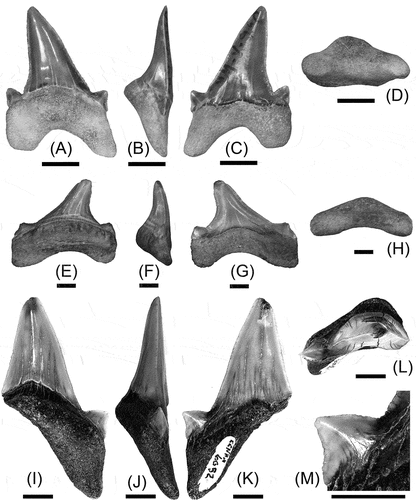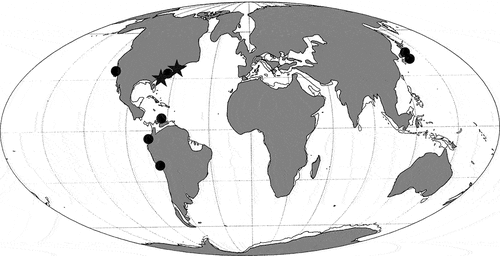Figures & data
Figure 1. Stratigraphic and geographic positions of specimens of Megalolamna described in this paper. (A) Oligocene to early–middle Miocene geochronology showing stratigraphic position of Calvert Formation of Maryland, USA, and Chandler Bridge Formation of South Carolina, USA, as well as stratigraphic horizons of the specimens (arrow marks; generalized geologic column showing Chandler Bridge Formation is included because the occurrence of Megalolamna marks the oldest geologic record for the genus) (stratigraphic information based on Weems et al. (Citation2016, figure 8), Vogt et al. (Citation2018, figure 1.3), and Fallon and Boessenecker (Citation2020, figure 1C)). (B) map of continental USA (middle) showing Maryland (top) and South Carolina (bottom) along with localities of Megalolamna specimens described in this paper (stars).

Figure 2. Teeth of Megalolamna described in this paper. (A)–(D), tooth of M. paradoxodon (CMM-V-10306) from Calvert Formation of Maryland, USA, in lingual (A), mesial (B), labial (C), and basal (D) views. (E)–(H), tooth of M. paradoxodon (CMM-V-10270) from Calvert Formation of Maryland, USA, in lingual (A), mesial (B), labial (C), and basal (D) views. (I)–(M), tooth of M. cf. M. paradoxodon (CCNHM 6052) from the Chandler Bridge Formation of South Carolina, USA, in lingual (I), mesial (J), labial (K), and apical (L) views, and close-up view of mesial lateral cusplet (M). All scale bars = 5 mm.

Figure 3. Geographic distribution of previous records (circle) and newly described records (star) of Megalolamna (Carrillo-Briceño et al. Citation2016, 2020; Shimada et al. Citation2017; this study) using early Miocene (Aquitanian‒Burdigalian) palaeogeographic map (after Smith et al. Citation1994, p. 27).

